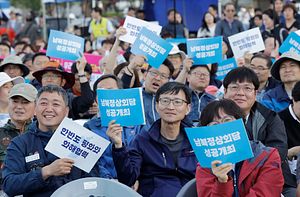When Supreme Leader Kim Jong-un of North Korea and President Moon Jae-in of South Korea meet on April 27, the prospects look good for continuing the near-term reduction in inter-Korean tensions and for establishing a longer-run process for improving North-South relations. At the conclusion of the talks, the two leaders will likely announce a handful of agreed steps to be taken and plans for negotiations to continue between officials at the ministerial levels of their respective governments.
Practical results can follow rather quickly in political, economic, cultural, diplomatic and military spheres. The military sphere is complicated by the U.S.-South Korean alliance, but rapid progress can be made on institutionalizing military-to-military communications and procedures for de-conflicting activities and incidents which may be perceived as threatening during drills and exercises.
The two Korean leaders may agree to pursue completion of, or even sign, a new version of the “Joint Declaration of the Denuclearization of the Korean Peninsula.” The 1992 declaration is outdated given the changes the overall security environment in northeast Asia and North Korea’s acquisition of nuclear weaponry.
The Korean leaders may also discuss updating the principles of Reunification, stated in the July 4, 1972 South-North Joint Communiqué. The goal of reunification is still alive in both parts of the Korean Peninsula and remains an integral part of the official national visions for both the North and South. However, it is now widely believed that neither the Greater Republic of Korea or a Korea united under the ideological banner of North Korea is feasible. The two countries could learn to be good neighbors and act cooperatively while remaining independent states. In time, it may be possible to create a Korean federation or commonwealth with a constitution that recognizes a fairly high degree of autonomy for North and South.
Before South and North Korea move further toward a new model of reunification or a more stable two-state Korean Peninsula, they must first mutually recognize the legitimacy of each state. At present they call each other “criminal states” and “occupied territories” and their respective constitutions and other legal documents recognize the legitimacy of only one regime.
The decision of the two leaders to meet in Korea constitutes a kind of tacit mutual recognition of the two states. If they did not accept each other as an independent state, this meeting would take place somewhere in the third country or in the presence of the third country host. The readiness of both state leaders to meet signals recognition of each other as legitimate states. Time will be required to make appropriate amendments to the legal basis of new inter-Korean relations.
During the Olympics this year, North and South Korea resumed cultural cooperation. Recent cultural events have proven successful and mutually agreeable, providing a good foundation to plan more exchanges of delegations and joint artistic performances. Inter-Korean goodwill can follow from resuming separated family visits and are making them easier to arrange.
As for economic sphere, it is more sensitive given the sanctions imposed on North Korea by the United Nations Security Council. There is room for South Korea to adjust or lift a number of unilateral sanctions including the May 24 sanctions imposed by Seoul after the incident with the Cheonan corvette in 2010. It is noteworthy that the person blamed for the Cheonan incident, Kim Yong-chol, former chief of the General Reconnaissance Bureau, took part in the Winter Olympic closing ceremony in Pyeongchang despite being sanctioned in 2010 by then-U.S. President Barack Obama.
The Moon Jae-in government has declared a New Northern Policy including projects of economic cooperation with Russia and North Korea. The summit could produce an agreement to begin serious talks about renewing trade and investment, including reopening joint cooperation zones in Kaesong and Kumgansang. This could lead to further easing of South Korea’s unilateral sanctions.
Because the United States views Korea as being within the sphere of its interests and influence, the United States will find it very difficult to sit on the sidelines if there is progress in the inter-Korean talks. A similar calculation by China probably led to the recent Xi-Kim summit in Beijing.
One of the most favorable outcomes of the inter-Korean summit to look for in the first week of May will be an announcement from Washington of a date and place for the summit meeting of U.S. President Donald Trump and Kim Jong-un. This first round of summitry between the United States and North Korea is likely to only bring significant progress if diplomatic contacts are nurtured by both sides and they pursue a serious agenda over the longer term. However, a Trump–Kim summit, even one limited to empty talk, is by its very occurrence a serious accomplishment.
Despite the general desire by the United States to maintain status quo arrangements in Korea, especially regarding the U.S.-South Korea alliance, the United States can benefit from inter-Korean rapprochement. It is notable that North Korea once proposed helping the United States in deterring China in a proposal made by Vice Foreign Minister Kim Kye-gwan during his visit to New York in 2007. When Kim Jong-il met with South Korean President Kim Dae-jung in 2000 in Pyongyang, he promised to normalize relations with the United States and said: “US forces should remain on the Korean Peninsula even after unification.” These suggest that North Korea is open to a variety of negotiable arrangements that can meet both its interests and those of the United States.
Much will depend on U.S. readiness to negotiate and its willingness to adapt to the changing international conditions in northeast Asia. With an improvement of U.S.-North Korea relations, tensions in the region will not disappear, but instability will be more manageable and there will be less risk of a war engulfing Korea and beyond.
Anastasia O. Barannikova is a research fellow at the Center for Maritime International Studies, Admiral Nevelskoy Maritime State University, Vladivostok, Russia. She is completing her PhD in history at Far Eastern Federal University.

































